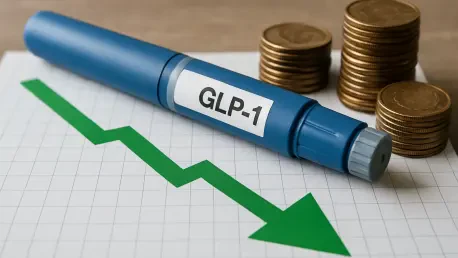In a landmark development that could transform the affordability of critical medications for millions of Americans, the Trump administration has finalized a historic agreement with pharmaceutical powerhouses Eli Lilly and Novo Nordisk to significantly reduce the prices of GLP-1 drugs by 2026. These medications, including well-known names like Ozempic, Wegovy, Mounjaro, and Zepbound, are essential for managing diabetes and obesity, conditions affecting a substantial portion of the population. However, their high costs have often placed them out of reach for many who need them most. Announced on a Thursday, this deal not only targets the financial burden of these drugs but also sets a precedent for broader reforms in prescription drug pricing across the United States. Beyond GLP-1 medications, the agreement encompasses other vital treatments and introduces innovative policy measures, signaling a potential shift in how healthcare costs are addressed on a national scale.
Key Features of the Pricing Breakthrough
This agreement marks a pivotal moment for healthcare affordability, with specific price reductions set to take effect in January 2026. Through a newly introduced platform called TrumpRx, patients will gain access to GLP-1 drugs at drastically lowered rates. Monthly costs for Ozempic and Wegovy will be set at $350, while Zepbound will average $346, with slight variations based on dosage. For Medicare patients, the deal offers even greater relief, with prices dropping to $245 per month and a copay of just $50 starting as early as April 2026. Additionally, if the FDA approves oral versions of these medications, initial doses will be priced at a remarkably low $150 per month. This initiative aims to directly connect patients with manufacturers, sidestepping traditional intermediaries and ensuring that savings are passed on to those who need them most, particularly individuals managing chronic health conditions with limited financial resources.
The scope of this deal extends well beyond GLP-1 drugs, incorporating other essential medications to broaden its impact on public health. Eli Lilly has committed to slashing prices on its migraine treatment, Emgality, to $299 per pen, and its diabetes drug, Trulicity, to $389 per month, offering significant discounts to patients. Both Eli Lilly and Novo Nordisk have also reaffirmed their pledge to cap insulin prices at $35 per month, aligning with prior commitments to make this life-saving treatment more accessible. These reductions target a wide range of chronic conditions, addressing the often prohibitive out-of-pocket costs that burden many American households. By including such a diverse array of medications, the agreement underscores a comprehensive approach to tackling drug affordability, potentially setting a model for future negotiations with other pharmaceutical entities in the industry.
Innovative Policies for Fair Pricing
A cornerstone of this deal is the implementation of the Most Favored Nation (MFN) pricing policy, designed to eliminate the stark disparities in drug costs between the United States and other developed nations. Under this framework, Eli Lilly and Novo Nordisk are required to offer their medications at the lowest price they provide to any comparable country, ensuring that American patients are no longer disproportionately charged. Currently, U.S. consumers pay over three times more for brand-name drugs than their counterparts in similar economies, a gap that this policy seeks to close. Additionally, the MFN approach mandates that the companies repatriate increased foreign revenue on existing products and extend these discounted prices to state Medicaid programs, aiming to create a more equitable pricing structure that benefits a broader segment of the population across various economic backgrounds.
While the MFN policy holds promise for reducing costs domestically, it has sparked debate over its potential global repercussions. Critics argue that aligning U.S. prices with those in other nations could lead to unintended consequences, such as higher costs in countries with more constrained healthcare budgets, potentially undermining access to essential medications worldwide. Furthermore, the policy does not address deeper systemic issues within the U.S. healthcare system, such as the opaque rebate practices of pharmacy benefit managers or the limitations on Medicare’s ability to negotiate prices directly. Despite these concerns, the White House emphasizes that the current system unfairly burdens American patients, who often subsidize lower prices abroad through inflated domestic costs. This policy represents a bold step toward fairness, though its long-term effectiveness and international impact remain subjects of ongoing analysis and discussion among experts and stakeholders.
Incentives for Industry and Domestic Investment
As part of the agreement, Eli Lilly and Novo Nordisk are granted substantial incentives to offset the financial impact of the price reductions. Both companies will benefit from a three-year exemption from tariffs, a significant advantage given the administration’s consideration of imposing up to 100% tariffs on imported branded drugs for firms not investing in new U.S. manufacturing facilities. This exemption provides financial predictability and relief, allowing the companies to plan their operations without the looming threat of additional costs. Such measures reflect the administration’s dual focus on lowering drug prices for consumers while simultaneously encouraging pharmaceutical giants to align with national economic goals, particularly in strengthening domestic production capabilities and reducing reliance on foreign supply chains that can be vulnerable to disruption.
In tandem with these incentives, both companies have made robust commitments to enhance American manufacturing, aligning with broader policy objectives to bolster local economies. Novo Nordisk has pledged an additional $10 billion investment in U.S. production facilities, including plans to manufacture the Wegovy pill entirely within the country. Eli Lilly, which has already invested approximately $27 billion in domestic operations, continues to expand its footprint in the United States. These investments are expected to create jobs and stimulate economic growth in communities hosting the facilities, while also ensuring a more secure supply of critical medications. By linking price reductions to such commitments, the administration aims to foster a symbiotic relationship between affordability for patients and industrial growth, potentially setting a precedent for how future agreements with other sectors might be structured to achieve multiple national priorities.
Financial Markets and Long-Term Projections
The announcement of this deal triggered varied responses in the financial markets, reflecting the complex interplay between affordability initiatives and corporate profitability. On the day of the unveiling, Eli Lilly’s stock saw a rise of 1.26%, suggesting investor confidence in the company’s ability to adapt to the new pricing structure while benefiting from tariff exemptions. Conversely, Novo Nordisk experienced a decline of 3.31%, likely driven by concerns over reduced revenue streams in the near term. However, subsequent market activity showed signs of recovery, with Lilly’s stock surging by 4.73% and Novo Nordisk posting a modest gain of 0.33% by the following Monday. These fluctuations indicate a cautious optimism among investors, who appear to be weighing the short-term financial hits against the potential for expanded market access and long-term stability in the pharmaceutical sector.
Looking ahead, the financial implications for both companies reveal a delicate balance between immediate losses and future gains. Novo Nordisk has projected a low single-digit negative impact on its global sales growth for 2026 due to the pricing agreement, acknowledging the trade-off inherent in lowering costs. Yet, this move could enhance public goodwill and increase patient access, potentially driving higher volume sales over time. Analysts suggest that while the initial revenue dip poses challenges, the strategic positioning of both companies—through domestic investments and policy incentives—may mitigate these effects. The market’s evolving reaction underscores the uncertainty surrounding such sweeping changes, as stakeholders continue to assess how these price cuts will reshape competitive dynamics and influence future innovation within the industry, particularly for high-demand medications like GLP-1 drugs.
Healthcare Trends and Systemic Challenges
This agreement shines a spotlight on broader trends shaping U.S. healthcare policy, particularly the urgent need for transparency in drug pricing and innovative distribution models. The introduction of TrumpRx as a direct-to-consumer platform represents a significant shift, aiming to bypass traditional intermediaries like pharmacy benefit managers that often inflate costs. By targeting high-profile GLP-1 drugs, which have gained widespread attention for their effectiveness in managing diabetes and obesity, the administration addresses a critical public health concern that resonates with millions of Americans. However, the success of this platform will hinge on its implementation, ease of use, and adoption by both patients and healthcare providers, as well as its ability to navigate logistical and regulatory hurdles that could impede its reach and effectiveness in delivering promised savings.
Despite the strides made by this deal, it also highlights the limitations of addressing drug affordability without comprehensive systemic reform. Key structural issues, such as Medicare’s inability to negotiate drug prices directly or patent laws that delay the entry of generics, remain unaddressed. While the agreement offers immediate relief for specific medications, it falls short of tackling the root causes of high healthcare costs in the United States, where expenses continue to outpace those in other developed nations. Critics argue that without broader legislative changes, such initiatives risk being piecemeal solutions to a deeply entrenched problem. Nevertheless, this deal serves as a tangible step forward, providing a foundation upon which future policies might build to create a more equitable and sustainable healthcare system for all Americans facing the burden of chronic illness.
International Ramifications and Ethical Dilemmas
The MFN pricing policy, while aimed at benefiting American consumers, introduces a complex set of international implications that cannot be overlooked. Critics, including legal and health policy researchers, caution that aligning U.S. drug prices with those in other countries could result in price increases abroad, particularly in nations with universal healthcare systems or limited budgets. Such a shift risks exacerbating global health inequities, as less affluent countries may struggle to afford essential medications if manufacturers adjust their pricing strategies to offset losses in the U.S. market. This potential outcome raises profound ethical questions about balancing national interests with global access to life-saving treatments, prompting a need for careful monitoring of how this policy unfolds on the world stage in the coming years.
Adding to the complexity, the pharmaceutical industry has voiced concerns that reduced revenues in the U.S. market could stifle research and development efforts. Industry representatives argue that high domestic prices have historically funded innovation, benefiting patients worldwide through the creation of new therapies. If this financial model is disrupted, the pace of developing cutting-edge treatments might slow, potentially delaying access to future cures. Proponents of the deal counter that the current system unfairly places the burden on American patients to subsidize global innovation, a disparity that MFN pricing seeks to rectify. This tension between affordability and the sustainability of medical advancements remains a central debate, highlighting the intricate challenges of reforming drug pricing in a way that serves both immediate needs and long-term progress in healthcare innovation globally.
Reflecting on a Path Forward
Looking back, the Trump administration’s negotiations with Eli Lilly and Novo Nordisk to reduce GLP-1 drug prices stood as a significant milestone in the ongoing battle against soaring healthcare costs. The establishment of discounted rates through TrumpRx, alongside commitments to domestic manufacturing and the adoption of MFN pricing, demonstrated a multifaceted approach to enhancing affordability. However, the journey did not end there. Moving forward, policymakers were urged to build on this foundation by addressing systemic barriers, such as empowering Medicare to negotiate directly and reforming patent laws to encourage generic competition. Additionally, international collaboration emerged as a critical next step to mitigate the risk of global price disparities, ensuring that affordability in one nation did not come at the expense of access in others. This deal, while a notable achievement, underscored the importance of sustained efforts to balance cost, innovation, and equity in shaping a healthier future for all.









